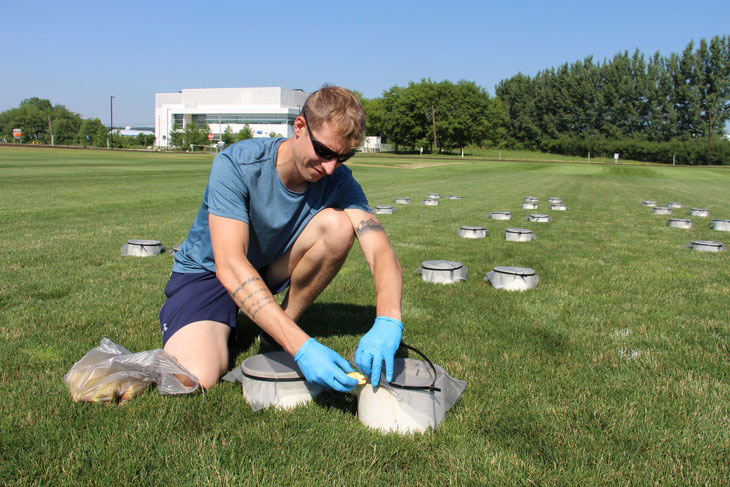
Penn State graduate student Andrew Huling tends to the Japanese beetles that are part of a study focusing on insecticide efficacy and grub control. Photo by Amy Duke
Editor’s note: The following research project is funded in part by a grant to GCSAA from the Environmental Institute for Golf.
Grubs are, well, gross.
Lack of “cute factor” aside, what athletic field managers, golf course superintendents and homeowners find most repulsive about these tiny beetle larvae is their voracious appetite for grass roots, and the insidious way they go about satisfying their craving, feeding below the surface, undetected, for months.
The most detested of these is the offspring of the Japanese beetle, which can damage root systems so severely that turf can be rolled back like a carpet. The U.S. Department of Agriculture reports that losses attributable to this type of white grub come to $234 million per year, an amount that represents $156 million to replace damaged turf and $78 million for control costs.
Those control costs likely include the use of a neonicotinoid insecticide — imidacloprid — which is one of the most widely used insecticides in the world. While it has been a popular choice for curtailing the number of gluttonous grubs, in recent years, it has seemed to be losing its effectiveness, and researchers in Penn State’s College of Agricultural Sciences want to know why.
“We are hearing from the golf industry that it’s becoming harder to control grubs, especially at sites that have used imidacloprid for years,” says Andrew Huling, master’s degree candidate in turfgrass entomology in the Department of Plant Science. “Since grubs spend about 10 months of their pre-adult life in the soil, they can cause a lot of damage if not controlled. We need to find a solution.”
For this reason, Huling and his adviser, Ben McGraw, associate professor of turfgrass science, are halfway through a two-year field study on the residual activity of imidacloprid in turfgrass. Their research is taking place at the Joseph Valentine Turfgrass Research Center on Penn State’s University Park campus, a facility Huling describes as “world-class” when it comes to turfgrass research.
McGraw explains that neonicotinoids revolutionized white grub management because their lengthy residual activity meant they could be applied preventively (in advance of egg laying), which reduced the need to scout for pest presence — and meant pest presence could potentially be underestimated.
“Andrew and I have both been really surprised to find that imidacloprid concentrations dramatically declined in soils collected from sites that used the active ingredient year after year,” McGraw says.
The duo has thoughts as to why this may be happening. They speculate that cultural practices — such as thatch management — and microorganisms in the soil may reduce uptake and prematurely degrade the insecticide. To test these theories, Huling is currently conducting experiments under field conditions, which requires trapping thousands of beetles a day.
Using sections of 8-inch plastic pipe positioned in the ground, the researchers have created “mating arenas,” each housing between 40 and 50 adult Japanese beetles. After the insects mate and the females have laid their eggs in the soil, Huling sprays different concentrations of imidacloprid at different times. As soon as the grubs hatch, they begin feasting on the treated roots.
“After about a month, we remove soil cores and physically break them up and look for larvae while also measuring imidacloprid concentration within the root tissue,” Huling says. “We are documenting the conditions that are the most effective — and least effective — in controlling grub populations.”
Huling and McGraw will use this data collection to develop recommendations on application timing, concentrations, proper soil composition and watering methods to counteract potential insecticide breakdown.
“Andrew’s project has had some interesting twists and turns in a relatively short time,” McGraw says. “Like many research projects, the path that he started on was abandoned once the data started rolling in. It has been fascinating to see the project evolve and Andrew develop as a scientist.”
Ed Rajotte, professor of entomology and integrated pest management coordinator, and Mary Ann Bruns, associate professor of soil microbiology and biogeochemistry, have also been instrumental in the research, which has received funding from GCSAA and the New York State Turfgrass Environmental Stewardship Fund.
“It’s gratifying to be able to conduct research that can help the industry and homeowners,” says Huling, who received a bachelor’s degree in turfgrass science from Penn State in 2016. “It would not have been possible without the guidance and support that I have received from the faculty at Penn State — they are empowering me to pursue my passion.”